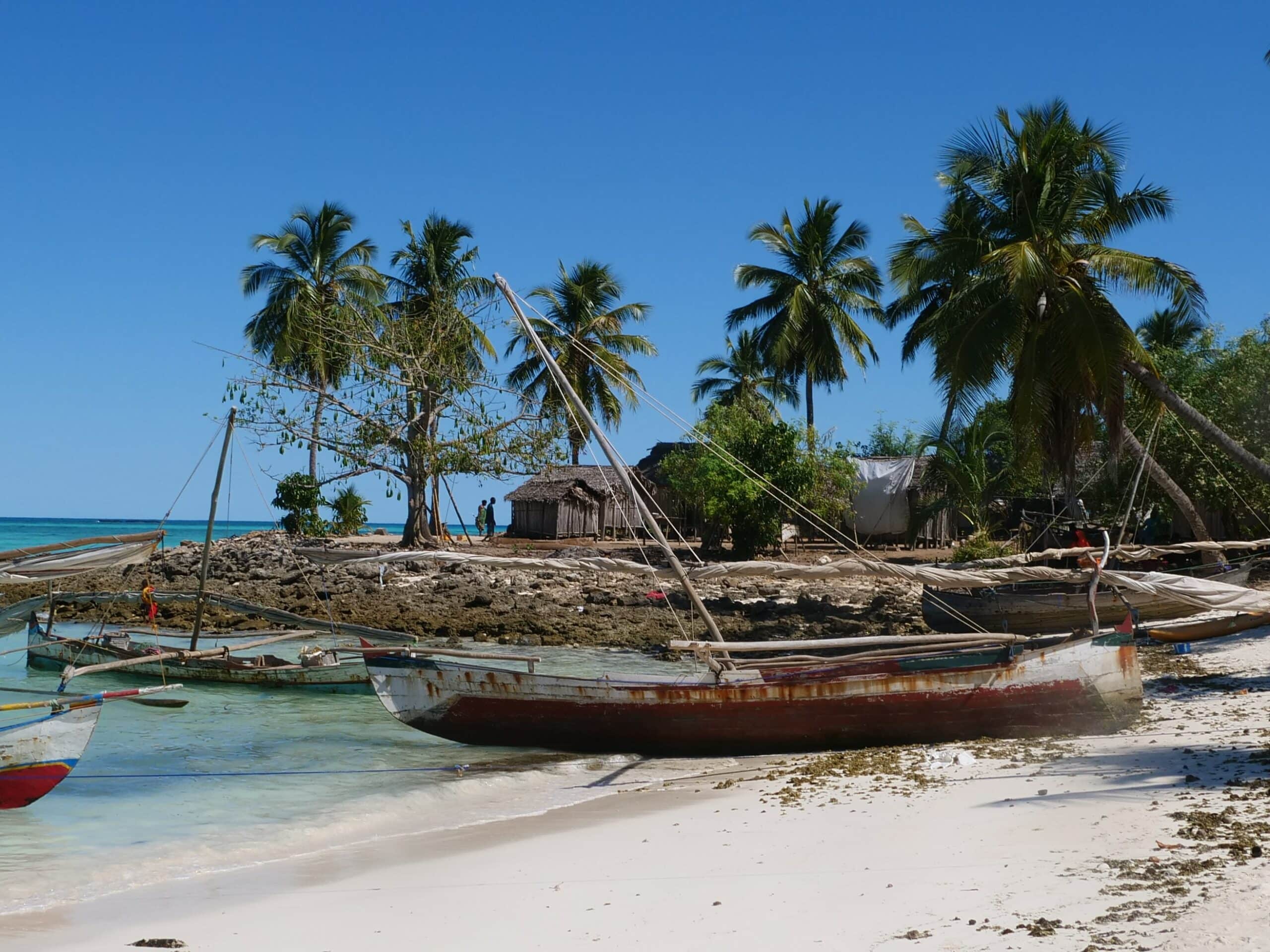Are you ready to take on a new challenge in the world of plants? Have you ever considered growing a Madagascar Palm in your home or garden? This exotic and striking plant is sure to bring life and beauty to any space. As a specialist in botany and gardening, I am here to provide you with all the tips and tricks necessary for successful cultivation and care of this unique species.
The Madagascar Palm is an attractive plant, native to tropical Africa, with long fronds that are segmented into leaflets. While these palms may appear intimidating at first due to their size, they are surprisingly easy to grow with minimal effort. With the right information and guidance, anyone can learn how to successfully cultivate their own Madagascar Palm.
In this guide, I will provide you with detailed instructions on how to select the best variety of Madagascar Palm for your needs, as well as step-by-step advice on properly planting it and caring for it throughout its growth cycle. Additionally, I will discuss some common problems that may arise while caring for this delicate species and what can be done to prevent them from occurring. So if you’re ready – let’s get started!
Understanding Madagascar Palms
Madagascar palms, scientific name Pachypodium lamerei, are members of the succulent plant family Apocynaceae. As tropical plants, they are native to the island of Madagascar and can be found in open woodlands and savannas. These plants are slow growing but can reach a height of up to 20 feet when mature. They have an upright trunk with gray bark that is covered with spines and a crown of long, slender green leaves.
The care for Madagascar palms will depend on the climate that it is grown in as well as whether it is grown indoors or outdoors. For indoor plants, watering should be done sparingly; too much water can cause root rot. Soil should be well-draining and fertilizing should only be done in moderation. Outdoors, Madagascar palms need full sun and plenty of space to grow. It’s important to protect them from frost if you live in an area where temperatures drop below freezing during winter months.
Providing your Madagascar palm with the right conditions is essential for it to thrive. Knowing its preferred light levels, soil type and water requirements will help ensure that your plant is healthy and happy – no matter where you choose to grow it! With proper care, these plants make great houseplants or outdoor additions to any garden.
Ideal Growing Conditions For Madagascar Palms
Growing a Madagascar palm is an attractive and rewarding endeavor. These exotic-looking plants are surprisingly easy to care for, but they do require specific conditions in order to thrive. Let’s take a deeper dive into the ideal growing conditions for these interesting palms.
The Madagascar palm needs plenty of bright, indirect sunlight. It is best to place them in a spot that gets at least 6 hours of sun per day, but it should be filtered light rather than direct sunlight for most of the day. It can also tolerate partial shade and requires well-draining soil with a neutral pH balance. Be sure to avoid overwatering as too much moisture can cause root rot or fungal infection.
When it comes to temperature, the Madagascar palm prefers temperatures between 65°F and 85°F (18°C and 29°C). The plant will become dormant when temperatures drop below 50°F (10°C), so if you live in an area with cold winters, you may need to bring your Madagascar palm indoors during cooler months. With proper care and attention, this tropical beauty will reward you with its lush foliage year round!
Preparing The Soil For Planting
As the old adage goes, “You reap what you sow.” This rings true when it comes to planting Madagascar palms. Preparation of the soil is key to ensure that these palms receive the nutrients they need for their growth and development. With some proper attention and care, growing a healthy, beautiful Madagascar palm can be easy.
When prepping the soil for planting, there are several important steps to consider. First, a well-draining soil is necessary so that water does not sit and cause root rot. To achieve this, one can add organic material such as compost or peat moss to promote good drainage. Additionally, it is important to mix in fertilizer with a low nitrogen content and ensure that the pH level of the soil is between 5 and 6.5 for optimal growth.
Furthermore, if planting multiple Madagascar palms in close proximity to each other, it is important to create raised beds for each individual plant rather than planting them all in one bed. This helps prevent competition between plants for resources and allows them room to spread out their roots as they grow larger. It also allows for better aeration of the soil which can help prevent diseases from developing in any of the plants’ roots systems.
Overall, preparing one’s soil before planting Madagascar palms requires time and effort but will definitely pay off when it comes time to enjoy a lush garden full of these beautiful tropical plants!
Planting Madagascar Palms
Planting a Madagascar palm is not only a great way to add to the beauty of your home, but also an investment for the future. It’s important to be mindful of the soil preparation before planting, as well as the specific instructions that come with each plant.
When it comes time to plant, you’ll want to make sure you have an adequately sized hole in which to place your new palm. Depending on your particular type of palm, this hole should be at least twice as wide as the root ball and 3-4 times its depth. Once you’ve dug out your hole, you can begin the process of adding organic matter such as compost or aged manure. This will help ensure that the roots are able to thrive and access all their necessary nutrients.
Once you’ve filled your hole with organic matter, it’s time to put your Madagascar palm in its new home! Gently remove it from its original pot and place it into the prepared soil. Tamp down gently around the base of the plant so that it’s secure and then fill any remaining gaps with more soil or compost. Remember to water thoroughly after planting and continue providing regular water for a few weeks until your palm is established in its new location!
Watering And Fertilizing Madagascar Palms
Watering and fertilizing a Madagascar Palm is like nurturing a child; it’s essential to its growth and health. As specialists in botany and gardening, we know that without proper care and attention, these plants can quickly become unhealthy.
We suggest watering your palm twice a week with one to two gallons of water. Remember to check the soil first; if it feels damp, don’t add any more water. You should also fertilize your palm every four weeks using a balanced liquid fertilizer or a slow-release granular fertilizer. This will help ensure healthy growth.
It’s important to remember that too much water or fertilizer can damage the plant, so be sure not to overdo it! The key is finding the right balance for your palm’s needs. With regular watering and fertilization, you can help your Madagascar Palm reach its full potential and thrive for years to come. Now let us move on to pruning and trimming this beautiful species of plant.
Pruning And Trimming Madagascar Palms
Ah, the joys of pruning and trimming a Madagascar Palm. It’s a task that brings a certain level of satisfaction to the gardening enthusiast. One must delicately balance the art of enhancing its aesthetic beauty while maintaining its health and integrity. As a specialist in botany and gardening, I can help you understand how to properly groom your beloved palm.
The first step is to identify any dead or diseased fronds, stems, or trunks. They should be removed as soon as possible to prevent further damage and spread of infection. You’ll want to use sharp pruning shears for best results – dull tools can cause tearing or splitting of vital parts of the plant. Additionally, it’s important to wear protective gloves when dealing with prickly leaves or spines – no one wants their hands getting scratched up!
Next comes shaping your Madagascar Palm. This will depend on the qualities you want from your plant – either an upright form with evenly spaced foliage or a more rounded shape with greater coverage at the base. To achieve this, remove any growing points that are outside of your desired pattern and trim off excess foliage in order to create an aesthetically pleasing look. With regular pruning and trimming, you can ensure that your Madagascar Palm will become an attractive centerpiece in your garden!
By following these steps, you’ll have a gorgeous Madagascar Palm that is healthy and properly maintained – ready to bring joy into your life!
Controlling Pests And Diseases Of Madagascar Palms
Pest and disease control is an integral part of successful cultivation of Madagascar Palms. There are a number of pests and diseases that can affect these plants, including scale insects, mealybugs, fungal diseases, and root-rotting fungi. It’s important to inspect your palms regularly to ensure any problems are spotted early on.
Controlling pests and diseases involves good cultural practices such as planting in well-draining soil, avoiding overcrowding, and providing adequate air circulation. Regularly removing dead leaves and debris will also help reduce the risk of infection or infestation. Additionally, chemical treatments may be necessary if the problem is severe.
If you do decide to go down this route, always read the label instructions carefully and take great care to avoid over-application or contact with other plants nearby. And remember – prevention is better than cure! By following the above steps you should be able to keep your Madagascar Palms healthy and thriving for many years to come. With just a little extra effort they can be propagated too – giving rise to even more beautiful specimens!
Propagating Madagascar Palms
Propagating Madagascar palms is a rewarding task, as it allows you to create new specimens from existing plants. To propagate these palms, you’ll need to collect the seeds from mature fruits or use stem cuttings. Here are some tips for propagating Madagascar palms successfully:
- Collect the seeds from mature fruits when they turn brown and dry. Make sure the seed coat is intact before planting it in moist soil.
- For stem cuttings, take several 4-inch segments from the side of a healthy plant. Plant the cuttings in damp potting soil and keep them warm and humid until they form roots.
- Use rooting hormones on the stem cuttings for better success rates.
When propagating Madagascar palms, make sure to provide plenty of light and humidity, as well as nutrient-rich soil with good drainage. Water your plants regularly and keep them protected from cold drafts and direct sunlight exposure. With proper care, your newly propagated plants will soon be producing their own pups!
As you can see, propagating Madagascar palms is an easy process that requires minimal effort but yields great rewards! Now that you’ve got your new plants established, it’s time to think about repotting them so they can continue growing healthily.
Repotting Madagascar Palms
Repotting a Madagascar Palm is like giving a plant a much needed makeover. It’s essential for the long-term health of this gorgeous evergreen, and can also help to preserve its beauty. As specialists in botany and gardening, we understand that repotting can be intimidating – but with the right information and advice, you can give your plant the best care possible.
When succesfully repotted, Madagascar Palms will thrive indoors or outdoors in containers or in the ground. The process involves carefully removing it from its original container and transferring it into a larger pot with fresh soil. Make sure to choose a pot that’s just one size up from its current container so as not to overwhelm the roots of the plant. If you’re looking to add some decorative flair, consider using terracotta pots lined with sphagnum moss for extra drainage.
It’s important to remember that Madagascar Palms should only be repotted once every two years, as too frequent transplanting can cause stress and shock to their delicate root systems. So if you’ve recently given your Madagascar Palm a new home, sit back and enjoy watching them grow! With proper loving care and attention, these beautiful palms will reward you with years of lush greenery – an act of selfless service that will bring joy to both your heart and home.
Dealing With Overgrown Madagascar Palms
When it comes to dealing with an overgrown Madagascar palm, the most important thing is to act quickly. This type of palm is fast-growing and can soon become too large for its current pot. If you do not act quickly and transplant the plant, it will become root-bound and suffer from stunted growth and eventual death.
The ideal time for repotting a Madagascar palm is in spring when the weather is warmer and humidity levels are higher. Carefully remove the entire root ball from the pot and gently tease out any tangled roots before replanting into a larger container filled with fresh, well-draining soil mix. Make sure that you select a pot that has drainage holes to allow excess water to escape.
Once your palm is replanted, you should water regularly but allow the soil to dry out slightly between waterings to avoid overwatering. Fertilize monthly during spring and summer with a balanced fertilizer designed for palms or cacti. Trim away any dead or damaged leaves as needed with sharp pruners or scissors. With regular care, your Madagascar palm will remain healthy, vibrant and beautiful in your home for many years to come.
Caring for Madagascar palms in winter requires special attention since they are tropical plants that are not adapted to cold temperatures. Keep them away from drafts, cool windows, or air conditioners and make sure that their soil remains moist throughout winter months without becoming soggy or overly wet. Additionally, provide ample indirect light and reduce fertilization during this season as your palm’s growth rate will be slower than usual due to the cooler temperatures outside.
Caring For Madagascar Palms In Winter
Did you know that the Madagascar Palm, or Pachypodium Lamerei, is one of the most popular ornamental house plants? This palm is surprisingly easy to care for and can thrive in cooler temperatures. But what about caring for Madagascar Palms in winter? With the right measures, these palms can survive and even flourish during cold winter months.
When it comes to winterizing your Madagascar Palms, there are a few key steps to take. First, it’s important to reduce watering drastically. While these palms need regular water in warmer weather, too much moisture in winter can cause root rot and other diseases. Instead, allow the topsoil to dry out slightly before giving the plant a light misting with room-temperature water every two weeks or so.
Next, consider moving your potted Madagascar Palms indoors or into a sheltered area such as a garage or porch where they won’t be exposed to freezing temperatures or wind chill. When moving them indoors, make sure they’re placed near an east-facing window for indirect light and regular air circulation. Additionally, maintain a consistent temperature between 65°F (18°C) and 70°F (21°C). If you have more than one potted palm, you may also want to add a humidity tray beneath them to boost their overall health.
By following these steps for caring for your Madagascar Palms during colder months of the year, you can ensure their survival and promote healthy growth when spring arrives!
Growing Madagascar Palms Indoors
Growing Madagascar palms indoors can be a rewarding experience. Not only are they attractive and easy to care for, but they can also be used to bring the natural beauty of the outdoors into the home. Here are some tips for successful indoor cultivation of Madagascar palms:
- Provide bright, indirect light to your Madagascar palm. This will help it grow and thrive without burning its leaves.
- Water your palm regularly, making sure not to over-water it as too much moisture can cause rotting issues.
- Feed your palm every two weeks using a balanced liquid fertilizer during the growing season.
- Prune off brown or dead fronds on a regular basis to keep your plant looking tidy and healthy.
By following these simple steps, you’ll have a lush and vibrant indoor palm that you can enjoy all year round. As with any other houseplant, proper placement is key when growing Madagascar palms indoors – make sure to place them in an area where they will get adequate sunlight and ventilation. With the right care and attention, your indoor Madagascan palmy friend will be a beautiful addition to any home environment!
Using Madagascar Palms In Landscapes
Thought to be native to Madagascar, the Madagascar Palm is a great choice for adding texture and color to your landscape. This tropical plant looks great in gardens, patio containers or even indoors. When planted outdoors, Madagascar Palms can reach heights of up to ten feet, while indoor plants can stay much smaller. Let’s take a look at what it takes to use Madagascar Palms in landscapes, from planting and care requirements to potential problems with this beautiful species.
When planting a Madagascar Palm in your garden or container, make sure you choose an area with plenty of sun exposure and well-draining soil. If you plan on using mulch around the base of the plant, keep it away from the stem as it may cause rot if left too close for too long. Water your new palm deeply at least once a week during dry weather and provide an all-purpose fertilizer once per month during active growth periods. Pruning is also essential for maintaining the desired shape of your palm – prune back any dead fronds or stems whenever necessary.
Finally, while they are generally low maintenance plants, there are some potential problems associated with keeping a Madagascar Palm in your landscape. They are susceptible to common pests like mealybugs and spider mites but can be easily treated by applying insecticidal soap or neem oil as needed. In addition, they may also suffer from root rot if over watered or if their roots become waterlogged due to poor drainage in the soil. Fortunately these issues can usually be avoided by providing appropriate care and attention when growing this beautiful species!
Potential Problems With Madagascar Palms
It’s no surprise that Madagascar palms are popular in gardens and landscapes. After all, they are easy to care for and can live up to 10 years with proper maintenance. Yet despite their popularity, there are some potential issues that could arise when attempting to grow them. Let’s take a look at some of the problems you may encounter when growing your own Madagascar palm.
One statistic worth mentioning is that the majority of Madagascar palms suffer from root rot if planted in overly wet soil. Root rot occurs when the roots of a plant are submerged in water for too long, which can cause them to become soft and break down. As such, it’s important to always check the soil moisture level before planting your Madagascar palm and make sure it is not too wet.
Another issue you may experience with your Madagascar palm is leaf discoloration or yellowing leaves due to inadequate fertilization or improper watering practices. If this happens, you’ll need to adjust your fertilization schedule or start watering more regularly. Additionally, you should also keep an eye out for pests like mealybugs or scale insects which can feed on the sap of the plant and cause damage to its leaves and stems. To prevent infestations, inspect your plant regularly and treat any infected areas as soon as possible with insecticidal soap or neem oil.
Troubleshooting Tips For Growing Madagascar Palms
Growing Madagascar palms is like a journey – one filled with potential pitfalls, but also the promise of lush green foliage. As gardeners, we must be prepared to face challenges along the way. Fortunately, troubleshooting tips can help us keep our palms healthy and happy.
To start off, it is important to understand the environmental conditions in which Madagascar palms thrive. They need full sun and consistently moist soil; if this is not provided, then the leaves may yellow and drop off. Additionally, Madagascar palms are sensitive to frost so they should be planted in areas that are sheltered from cold temperatures. This can be achieved by planting them near walls or large trees that create a microclimate around the palm.
Fungal diseases can also be an issue when growing Madagascar palms. To reduce the risk of fungal growth, it’s important to maintain good air circulation around the plant by pruning any dead fronds regularly. However, if fungus does appear then fungicide sprays should be applied as soon as possible to prevent further spread of the disease. It’s also important to check for infestations of pests such as mealybugs or scale insects which can weaken a palm’s health if left untreated. If spotted then appropriate insecticides should be applied in order to control the population and protect your pal from further damage.
In short, while growing Madagascar palms requires patience and dedication, following these troubleshooting tips will ensure that you are rewarded with lush green foliage for years to come!
Frequently Asked Questions
What Types Of Soils Are Best For Growing Madagascar Palms?
It is true that any kind of palm tree needs excellent soil conditions to grow, but Madagascar palms are particularly demanding. Thankfully, with the right knowledge, you can provide your Madagascar palm with the best possible growing environment. Despite this, some may be concerned that they do not have the necessary expertise to make sure their palms thrive – however, it does not have to be as complicated as it sounds. With a little bit of effort and preparation, you can create the perfect soil for your Madagascar palms and ensure they reach their fullest potential.
To achieve this goal, it is important to remember that Madagascar palms prefer a well-drained soil with plenty of organic matter. The ideal soil should contain sand, silt and clay in equal amounts so as to ensure proper drainage while also maintaining adequate moisture levels. Additionally, adding mulch can help keep weeds at bay and add extra nutrients. Here is a list of items which you should consider when preparing soil for your Madagascar palms:
•tSand •tSilt •tClay •tOrganic matter •tMulch
When done correctly, these components will combine to create a rich and vibrant soil that your Madagascar palms will love. Furthermore, if you take the time every few months or so to check on the condition of the soil and adjust its composition if needed then there should be no need for additional fertilizers or other treatments. All in all, with a little bit of research and preparation you will be able to give your beloved Madagascar palm the best possible conditions in which to flourish!
How Often Should Madagascar Palms Be Fertilized?
Madagascar Palms are a unique, exotic species of palm trees native to the island of Madagascar. They are attractive, easy to care for, and make an excellent addition to any home landscape. As with any plant, proper fertilization is essential for the health and development of a Madagascar Palm tree. However, it is important to understand how often they should be fertilized in order to maintain their vibrant foliage and robust growth.
When it comes to fertilizing Madagascar Palms, it is best to follow the “less is more” approach. Over-fertilization can cause significant damage to these plants and should be avoided at all costs. Generally speaking, a slow-release fertilizer should be applied about three times per year – roughly once every four months – in order for the tree to get the nutrients it needs without risking over-fertilization. It is also important that you use a fertilizer specifically tailored for palms or other tropical plants.
When applying fertilizer, be sure not to apply too much at once as this can lead to nutrient burn or other damage due to over-application of nutrients. Additionally, make sure that you water your Madagascar Palm thoroughly after each application so that the fertilizer can be absorbed by the soil properly and reach the roots of your tree where it will do the most good. With careful attention and regular fertilizing, you can ensure your Madagascar Palm stays healthy and happy for years to come!
How Long Does It Take For Madagascar Palms To Reach Maturity?
Madagascar palms are a beautiful and unique plant species, with their long, slender fronds and stunning appearance. However, knowing how long it takes for them to reach full maturity is an important part of the growing process. With proper care and attention, these plants can reach full maturity in about two to three years.
Here are five tips for caring for your Madagascar palm during those crucial two to three years: • Make sure that the soil stays moist but not wet by watering when the top inch of soil is dry. • Feed your Madagascar Palm with slow-release fertilizer twice a year during spring and summer months. • Place your palm in an area with bright indirect sunlight or partial shade. • Regularly prune dead leaves away from your plant and remove any brown tips on healthy fronds. • Finally, watch out for scale insects that may appear on your plant’s leaves; if you see any, use a natural insecticide such as neem oil to treat them.
By following these steps and monitoring the growth of your Madagascar palm over time, you can ensure that it reaches its maximum potential in two to three years. With regular maintenance and care, you will be rewarded with this beautiful addition to your home or garden!
Are Madagascar Palms Suitable For Growing Indoors?
Madagascar palms, scientifically known as pachypodium lamerei, are an interesting species of succulent that can make a great addition to your home garden or indoor environment. But are they suitable for growing indoors? Let’s discuss the pros and cons.
First off, it’s important to note that Madagascar palms can reach mature heights of up to 12 feet and may not be appropriate for all indoor environments. However, if you have the room, this stunning plant could be a great conversation piece! Here are some tips for successfully growing them indoors:
• Keep the palm in bright indirect sunlight. • Water regularly – keeping the soil slightly moist at all times. • Fertilize once a month. • Repot every two years to ensure proper growth.
It is also important to remember that while they can survive indoors year round, they will thrive outdoors during warmer months with plenty of heat and direct sunlight. Additionally, Madagascar palms need lots of space, so if your apartment or house is small, you might want to consider alternative plants for your indoor garden.
Overall, if you have the room and resources available for properly caring for one of these fascinating plants, then a Madagascar palm can make a wonderful addition to any indoor environment!
Is There A Difference Between Male And Female Madagascar Palms?
Like the petals of a flower, Madagascar palms have a fascinatingly unique gender difference. Male and female plants have different characteristics that make them stand out from one another. As a specialist in botany and gardening, I can tell you that understanding the differences between male and female Madagascar palms is key to helping these plants thrive.
The main distinction between male and female Madagascar palms is size. Males grow larger than females, reaching heights up to 50 feet with trunks measuring up to 1 foot in diameter. On the other hand, female plants generally stay between 25-35 feet tall with trunks no more than 2 inches thick. Another noticeable difference is that males are commonly single-trunked while females tend to be multi-stemmed with multiple trunks growing from the base of the plant.
In terms of care, both genders need moist soil and bright indirect light. However, it’s important to note that male specimens require more water than females as they are prone to drying out quickly during long periods of drought or hot weather conditions. Additionally, if you’re looking for a palm tree that produces flowers or fruit, look for a female specimen as only these produce both blooms and fruit.
Providing your Madagascar palm with proper watering, sunlight exposure, and occasional fertilizer will ensure its health and growth regardless of gender – allowing you to enjoy this magnificent species for years to come!
Conclusion
We’ve come to the end of our journey discussing how to grow and care for Madagascar Palms. As we’ve learned, these exotic plants require specific soils, regular fertilizer, and a few years to reach maturity. They’re also suitable for growing indoors, and it’s important to know whether you have a male or female plant before planting.
But let’s step back a moment and take into account all that we’ve learned about this unique species. Are we really ready for the responsibility of caring for such an exquisite palm? Can we handle the commitment it requires? To be honest, I’m not sure if I’m up to the challenge!
For those brave souls who are willing to take on this task, I salute you! You have my admiration and respect – not only for your courage but for your dedication in caring for these magnificent palms. To make sure your Madagascar Palms thrive, remember: water them regularly, fertilize them with care and keep an eye out for pests. Then sit back and enjoy their beauty!






















![how to grow and care Parlor Palm [Chamaedorea Elegans] 37 dnghf74yw4s how to grow and care Parlor Palm [Chamaedorea Elegans] 36](https://green-life.blog/wp-content/uploads/2023/04/dnghf74yw4s-150x150.jpg)






